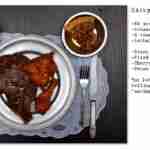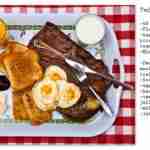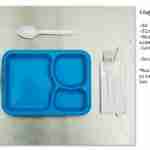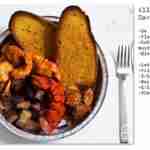There is something special about last meals, isn’t there?
I’d like to show you a series of photographs. These photographs, except for the last one – which I added, are from a piece called “No Seconds,” and they were put together by Henry Hargreaves.
I don’t want to belabor the artwork with my commentary, so I’ll give you a few seconds to take each slide in.











Now, I don’t know about you, but those pictures affect me deeply. The whole idea of a criminal’s last meal affects me deeply. Why?
I think it’s because these last meals combine the familiar with the unfamiliar. They combine the expected and the unexpected. I mean, on one hand, you’ve got comfort food. On the other hand, heinous crimes. The stuff of life right next to life’s untimely end.
While Jesus of Nazareth was no common criminal, his so-called “Last Supper” with his disciples was a poignant combination of the expected and the unexpected. And when you take a look at the Last Supper, focusing on its unexpected elements, you find out that it’s really a Lasting Supper.
That is, the Last Supper is not just a one-time event, some two-thousand years ago. Instead, Holy Communion, the Lasting Supper, is an ongoing meal, with profound implications for our past, our future, and our present.
The Meal
First, let’s look at the original meal itself, the “Last Supper,” as described in our Gospel lesson (Luke 22:14-20).
Passover: An Interpretive Celebration
Now, as expected, the Passover was an interpretive celebration, because it looked back to the Exodus event – when God rescued his people from slavery in Egypt – in order to explain what salvation looked like.
That is, if you asked any respectable Hebrew what it meant to “be saved,” you would much more likely hear “it’s like when God saved us from Egypt” than “you get to go to heaven after you die.”
Although Passover originated with Exodus 12’s instructions for a hasty meal, eaten while standing a fully dressed, by Jesus’ time the meal had evolved into an elaborate affair.
As best we can tell, in Jesus’ day the meal was structured around four cups of wine. According to New Testament scholar Joel Green, the meal had the following outline:
- The head of the family would pronounce a blessing over the first cup of wine, which was then shared.
- Before the second cup, the youngest son would ask the father questions about what made this night special.
- The father would reply by telling the Exodus story, focusing on the summary given in Deut. 26:5-11.
- The dinner party would then sing Psalm 113, and then drink the second cup of wine.
- The father would then bless, break, and distribute the unleavened bread, followed by the main meal.
- Finally, they would consume two more cups of wine, before singing Psalms 114-118.
Why am I telling you this?
Because we need to realize that the Passover was no ordinary meal.
Instead, it was an interpretive meal. Words went right along with the food, in order to situate the dinner party in the midst of God’s ongoing Story of Salvation.
Especially given the combination of the Exodus story with the prayers and praises found in Psalms 113-118, the Passover was
- a remembrance of God’s past deliverance,
- a celebration of God’s present faithfulness,
- and an anticipation of God’s future deliverance.
The past, the present, and the future came together in one meal.
Here’s the framework, or the timeline, if you will:
- The original Passover meal (Exod. 12)
- The Exodus from Egypt
- The establishment of the Covenant
- Yearly remembrance of the Passover
- In hope of future, final redemption
Got that?
Passover, Exodus, Covenant, Remembrance, Hope.
OK, so this is really important: Israel didn’t merely remember the Passover each year to know something but in order to change.
In other words, Passover was supposed to be a transformative remembrance.
Remembering God’s faithfulness was supposed to transform them into God’s faithful followers. Remembering God’s faithfulness was supposed to transform them into God’s faithful covenant partners.
So much for the expected aspects of the Last Supper: it was an interpretive Passover.
An Unexpected Paradigm Shift
What is unexpected about this meal is how Jesus shifts the paradigm! He takes the whole “Passover, Exodus, Covenant, Remembrance, Hope” timeline and makes himself the center of it!
As the “head of the household,” it’s not strange that Jesus would be the chief speaker during this Passover Meal. However, in vv. 15-16, things start to get weird. Jesus frames the meal as his last meal, prophetically looking forward to his suffering and death.
And yet, perhaps it’s better to say his “second-to-last meal,” because in verses 16 – 18, he predicts that death will not have the final word. Instead, he will partake of the full and final Passover again in the coming kingdom of God!
Remember, we’re expecting Jesus to give an explanation and interpretation of the Exodus story. When Jesus takes the bread and the wine, we expect him to say: “do this in remembrance of the Exodus from Egypt…do this in remembrance of the Covenant.”
Instead, he says: “do this in remembrance of ME!”
This shifts the timeline forward, from Israel’s transformative remembrance of the Passover to the Church’s transformative remembrance of the fulfillment of the Passover, the Lord’s Supper.
Passover points to the Lord’s Supper, Holy Communion.
New Exodus, New Covenant
What about the Exodus and the Covenant? Do they point to anything?
They do!
Both the Exodus and the Covenant are fulfilled in Jesus Christ, through the New Exodus and the New Covenant!
In the original Exodus, God saved his people, through Moses, from slavery in Egypt.
In the New Exodus, God saves his people, through Jesus Christ, from slavery to Sin and Death.
In the original Covenant, God gives his people the Law, through Moses, written upon tablets of stone.
In the New Covenant, God gives his people the Law, the Gospel! through Jesus Christ, and writes it upon their hearts.
We see this first in Jesus’ unexpected words about the bread, interpreted as Christ’s battered body.
Look at verse 19. Instead of the expected words about the Passover lamb at this point in the meal, Luke speaks only of Christ’s body, sacrificially “given” for the sake of his disciples.
Then, in verse 20, there are Jesus’ even more shocking words about the cup, which is interpreted as New Covenant blood!
Because the Jews were strictly prohibited from consuming blood (Deut. 12:16, 23-4), there were probably quite a few audible sputters when Christ declared: “this cup that is poured out for you is the new covenant in my blood” (Luke 22:20)!
Jesus is claiming that, just as the Old Covenant was ratified by blood (see Exod. 24:8), his impending death will ratify the New Covenant of Jeremiah 31:31-34. The sacrifice will be God himself, upon the Cross!
And, according to Jeremiah 31, the New Covenant will bring
- knowledge of God,
- loyalty to God, and
- forgiveness of sins.
Yahweh says:
“I will put my law within them, and I will write it on their hearts.
And I will be their God, and they shall be my people.
And no longer shall each one teach his neighbor and each his brother, saying, ‘Know the Lord,’ for they shall all know me, from the least of them to the greatest, declares the Lord.
For I will forgive their iniquity, and I will remember their sin no more” (Jer. 31:33-34).
Passover and Holy Communion: An Expanded Timeline
So, to review, the previous timeline was:
- Original Passover
- Original Exodus
- Establishment of the Covenant
- Israel’s Remembrance in Passover meals
- Hope for future, final redemption
Now, the church’s timeline builds upon the previous one:
- Original Last Supper
- New Exodus (accomplished at Cross)
- New Covenant (accomplished at Cross)
- Church’s Remembrance in Holy Communion
- Hope for future, final redemption
In Holy Communion, we Christians are called to the transformative remembrance of what Christ has accomplished at the Cross.
But we don’t just look back to the Cross. We also look forward to what Jesus will accomplish at the final redemption. You know, when he returns to judge the living and the dead, to right every wrong, and to wipe away every tear!
When we take Holy Communion, we await the heavenly banquet that will fully fulfill both the Passover and the Lord’s Supper.
Everyone with me so far?
Just as Passover was designed to be a transformative remembrance, to shape the Israelites into faithful followers of God, so too Holy Communion is a transformative remembrance.
It’s meant to transform us into faithful followers of Jesus Christ, faithful members of Christ’s body, the Church!
What Does Transformative Remembrance Look Like?
But, what does that look like?
Sure, I’ve mentioned that the New Covenant is meant to result in
- knowledge of God,
- loyalty to god,
- and the forgiveness of sins.
But seriously: What does that look like?
Let’s take a quick look at the rest of our passage, Luke 22:21-30.
Is anyone else confused by how quickly the scene seems to change?
I mean, one moment (v. 20), Jesus is saying the words of institution, and then the very next moment (v. 21-22) Jesus is predicting his betrayal!
In v. 23, the disciples are understandably confused. But then (v. 24) they immediately start bickering about who’s the greatest disciple!
So, Jesus has to remind them (vv. 25-30) that, in his kingdom, true greatness and authority come only through sacrificial service.
What in the world is going on here?
I think that these final scenes in our passage offer us a challenging reminder of how the Lord’s Lasting Supper should shape us.
They show us, albeit through the failure of Judas and the disciples, how the remembrance of Holy Communion should transform us into sacrificial servants of Jesus Christ and one another.
Servants? Or Traitors?
Let me put it to you this way:
When you come to the Lord’s Table, you either come as a servant or a traitor.
You either live a life of serving as you are served by Jesus, or you live a life of grabbing glory and honor and power for yourself.
In our New Testament lesson from 1 Corinthians, the Apostle Paul said the following:
“Whoever, therefore, eats the bread or drinks the cup of the Lord in an unworthy manner will be guilty concerning the body and blood of the Lord.
Let a person examine himself, then, and so eat of the bread and drink of the cup” (1 Cor. 11:27-28).
Now, you can ask yourself many different questions during this process of self-examination, but here’s one for your consideration: do my “table manners” match Jesus’ table manners?
Here are some of the last words of exhortation Jesus gives to his disciples:
“The kings of the Gentiles exercise lordship over them, and those in authority over them are called benefactors.
But not so with you.
Rather, let the greatest among you become as the youngest, and the leader as one who serves.
For who is the greater, one who reclines at table or one who serves?
Is it not the one who reclines at table?
But I am among you as the one who serves” (Luke 22:25-27).
I’ve got good news, friends: Jesus is still among us today as the one who serves.
Like always, he gives us his very self, for the sake of our salvation.
Will we follow his example? Will we gratefully accept his service, and – in joyful response to his salvation – serve others in Jesus’ name? Or will we come in betrayal, seeking honor for only ourselves?
Foot Washing
Now, during our service of Holy Communion, we are going to have a service of Foot-Washing. During that time, I’d like you to remember that the same Lord who washed his disciples’ feet – the dirtiest parts of their bodies – now washes away even the dirtiest parts of our lives with his blood.
And I’d like you to ask yourself: are you living a life of Christ-like service?
Sure, maybe you don’t wash other people’s feet all the time, but are you willing to sacrificially serve others, as you yourself have been served by Jesus?
The answer, by the way, is NOT “try harder! Be better! Serve more!” No!
INSTEAD, it is to surrender your entire life to Jesus. Only when you’ve accepted his salvation and his lordship will you be able to serve others out of the overflow of Christ’s love in your life.
The Lord’s Table
And of course, in addition to the foot-washing, we will come to the Lord’s Table. And, during that time, I’d like you to remember that the same Messiah who so frequently ate with outcasts and sinners now welcomes us outcasts and sinners to come to his table and receive the saving benefits of his broken body and his shed blood.
Friends, do our table manners match Jesus’ table manners? Are we reaching out to outcasts and sinners and welcoming them to our tables at home? Are we letting the hurting, the lost, and the broken around us know where they can find food and drink that lead to true, everlasting life?
Remember: the Lasting Supper is an ongoing meal, with profound implications for our past, our future, and our present.
When you come to the Lord’s table, you either come as a traitor or a servant.
Thanks be to God, who invites us all to the table of our Lord Jesus Christ, where he is the gracious host and we are the rebellious traitors who are transformed into faithful servants.
Amen.